Identifying Urban Built-Up Areas Based on Spatial Coupling between Nighttime Light Data and POI: A Case Study of Changchun
Abstract
:1. Introduction
2. Literature Review
2.1. Application of Nighttime Light Data in Research
2.2. Study of Nighttime Light Data Combined with POI
2.3. Summary
3. Methodology
3.1. Study Area Overview and Data Sources
3.1.1. Study Area Overview
3.1.2. Data Resource
3.1.3. Data Preprocessing
3.2. Extraction of Built-Up Areas
- (i)
- The data underwent pre-processing and nighttime lighting data for March 2022 were extracted using ArcGIS.
- (ii)
- The potential threshold value was set and the area of built-up area under this threshold value was calculated as follows: Let the maximum gray value be and the minimum gray value be 0. is the nighttime light data image of Changchun City in March. Let the area of the built-up area of Changchun based on statistics for the same period be . Then, the potential threshold of the nighttime light data image of Changchun City is calculated as:The area of built-up area extracted under the threshold is,where denotes a certain grayscale value between and and denotes the total area of the built-up area of Changchun City when the grayscale is .
- (iii)
- The difference between the built-up area under the potential threshold and the built-up area of Changchun based on the statistics were compared and the new threshold was reset until and are sufficiently close. At this point, the difference between and under is,
3.3. Kernel Density Analysis
3.4. Variable Normalization
3.5. Data Gridding
3.6. Two-Factor Combination Mapping
4. Results and Analysis
4.1. Overall Distribution
4.2. Comparison of Spatial Coupling Relationships
4.2.1. POI and NTL Coupling Relationship Is the Same
4.2.2. POI Is Higher Than NTL
4.2.3. POI Is Lower Than NTL
5. Conclusions
- (1)
- Spatial analysis in this study reveals significant spatial coupling between POI and NTL in Changchun in March 2022. Specifically, 84.58% of areas exhibit consistent coupling relationships (High–High, Medium–Medium, Low–Low), indicating a high spatial similarity between the datasets. The distribution, observed as a circular pattern around administrative district built-up areas, suggests a strong link between urban development and human activity patterns. Overall, these findings underscore the high complementarity of POI and NTL in analyzing urban spatial structure distribution.
- (2)
- Further analysis demonstrates that areas with diverse coupling relationships between POI and NTL offer a detailed characterization of urban structure spatial distribution. Clear identification of multiple central gathering areas is possible, with NTL indicating activity intensity but lacking specificity in function. Conversely, POI, concentrated in administrative district centers, better reflects commerce, industry, services, and entertainment. Thus, POI exhibits distinct spatial coupling characteristics compared to NTL.
- (3)
- After two zoning adjustments, Changchun’s spatial structure displays a polycentric nature. As the capital of Jilin Province, the main city encompasses most highly coupled areas, with each surrounding administrative district hosting a highly coupled urban center. However, peripheral areas, compared to the original administrative area, exhibit lower development levels, signaling a need for further development and planning.
- (4)
- Integrating POI and nighttime light data for built-up area extraction facilitates effective mapping of urban spatial structure and reveals development trends. Changchun’s development pattern, as a provincial capital, offers insights applicable to land planning in other Northeastern provincial capitals, highlighting the study’s generalizability.
Author Contributions
Funding
Data Availability Statement
Conflicts of Interest
References
- Qu, Y.; Zhan, L.; Jiang, G.; Ma, W.; Dong, X. How to Address Population Decline and Land Expansion (PDLE) of rural residential areas in the process of Urbanization: A comparative regional analysis of human-land interaction in Shandong Province. Habitat Int. 2021, 117, 102441. [Google Scholar] [CrossRef]
- Yin, C.; Meng, F.; Yang, X.; Yang, F.; Fu, P.; Yao, G.; Chen, R. Spatio-temporal evolution of urban built-up areas and analysis of driving factors—A comparison of typical cities in north and south China. Land Use Policy 2022, 117, 106114. [Google Scholar] [CrossRef]
- Hugo, G.; Champion, T. New Forms of Urbanization: Beyond the Urban-Rural Dichotomy; Taylor & Francis: Abingdon, UK, 2003. [Google Scholar]
- Zhou, Y.; Tu, M.; Wang, S.; Liu, W. A Novel Approach for Identifying Urban Built-Up Area Boundaries Using High-Resolution Remote-Sensing Data Based on the Scale Effect. Int. J. Geo-Inf. 2018, 7, 135. [Google Scholar] [CrossRef]
- Meng, Q.; Zhang, L.; Sun, Z.; Meng, F.; Wang, L.; Sun, Y. Characterizing spatial and temporal trends of surface urban heat island effect in an urban main built-up area: A 12-year case study in Beijing, China. Remote Sens. Environ. 2017, 204, 826–837. [Google Scholar] [CrossRef]
- Hou, Q. Spatio-temporal relationships between urban growth and economic development: A case study of the Pearl River Delta of China. Asian Geogr. 2012, 29, 57–69. [Google Scholar] [CrossRef]
- Wang, H.; Gong, X.; Wang, B.; Deng, C.; Cao, Q. Urban development analysis using built-up area maps based on multiple high-resolution satellite data. Int. J. Appl. Earth Obs. Geoinf. 2021, 103, 102500. [Google Scholar] [CrossRef]
- Zheng, Y.; Tang, L.; Wang, H. An improved approach for monitoring urban built-up areas by combining NPP-VIIRS nighttime light, NDVI, NDWI, and NDBI. J. Clean. Prod. 2021, 328, 129488. [Google Scholar] [CrossRef]
- Xie, Y.; Weng, Q. Updating urban extents with nighttime light imagery by using an object-based thresholding method. Remote Sens. Environ. 2016, 187, 1–13. [Google Scholar] [CrossRef]
- Ou, J.; Liu, X.; Li, X.; Li, M.; Li, W. Evaluation of NPP-VIIRS Nighttime Light Data for Mapping Global Fossil Fuel Combustion CO2 Emissions: A Comparison with DMSP-OLS Nighttime Light Data. PLoS ONE 2015, 10, e0138310. [Google Scholar] [CrossRef]
- Arfanuzzaman, M. Harnessing artificial intelligence and big data for SDGs and prosperous urban future in South Asia. Environ. Sustain. Indic. 2021, 11, 100127. [Google Scholar] [CrossRef]
- Zhang, Z.; Lin, X.; Shan, S. Big data-assisted urban governance: An intelligent real-time monitoring and early warning system for public opinion in government hotline. Futur. Gener. Comput. Syst. 2023, 144, 90–104. [Google Scholar] [CrossRef]
- Gao, X.Y. Study on Fusion of Multi-Source POI Based on the Spatial Location Information. Master’s Thesis, Ocean University of China, Qingdao, China, 2013. [Google Scholar]
- Wu, Y. Preprocessing of LBS based POI Data Updating. Comput. Digit. Eng. 2012, 40, 87–89. [Google Scholar]
- Zhou, Y.; Li, C.; Zheng, W.; Rong, Y.; Liu, W. Identification of urban shrinkage using NPP-VIIRS nighttime light data at the county level in China. Cities 2021, 118, 103373. [Google Scholar] [CrossRef]
- Yang, Z.; Chen, Y.; Guo, G.; Zheng, Z.; Wu, Z. Using nighttime light data to identify the structure of polycentric cities and evaluate urban centers. Sci. Total Environ. 2021, 780, 146586. [Google Scholar] [CrossRef] [PubMed]
- Liu, S.; Shi, K.; Wu, Y. Identifying and evaluating suburbs in China from 2012 to 2020 based on SNPP–VIIRS nighttime light remotely sensed data. Int. J. Appl. Earth Obs. Geoinf. 2022, 114, 103041. [Google Scholar] [CrossRef]
- Feng, Z.; Peng, J.; Wu, J. Using DMSP/OLS nighttime light data and K–means method to identify urban–rural fringe of megacities. Habitat Int. 2020, 103, 102227. [Google Scholar] [CrossRef]
- Hu, X.; Qian, Y.; Pickett, S.T.A.; Zhou, W. Urban mapping needs up-to-date approaches to provide diverse perspectives of current urbanization: A novel attempt to map urban areas with nighttime light data. Landsc. Urban Plan. 2020, 195, 103709. [Google Scholar] [CrossRef]
- Yang, Y.; Wu, J.; Wang, Y.; Huang, Q.; He, C. Quantifying spatiotemporal patterns of shrinking cities in urbanizing China: A novel approach based on time-series nighttime light data. Cities 2021, 118, 103346. [Google Scholar] [CrossRef]
- Yang, S.; Yang, X.; Gao, X.; Zhang, J. Spatial and temporal distribution characteristics of carbon emissions and their drivers in shrinking cities in China: Empirical evidence based on the NPP/VIIRS nighttime lighting index. J. Environ. Manag. 2022, 322, 116082. [Google Scholar] [CrossRef]
- Liu, Z.; He, C.; Zhang, Q.; Huang, Q.; Yang, Y. Extracting the dynamics of urban expansion in China using DMSP-OLS nighttime light data from 1992 to 2008. Landsc. Urban Plan. 2012, 106, 62–72. [Google Scholar] [CrossRef]
- Huang, C.; Zhuang, Q.; Meng, X.; Guo, H.; Han, J. An improved nightlight threshold method for revealing the spatiotemporal dynamics and driving forces of urban expansion in China. J. Environ. Manag. 2021, 289, 112574. [Google Scholar] [CrossRef] [PubMed]
- Wu, Y.; Li, C.; Shi, K.; Liu, S.; Chang, Z. Exploring the effect of urban sprawl on carbon dioxide emissions: An urban sprawl model analysis from remotely sensed nighttime light data. Environ. Impact Assess. Rev. 2022, 93, 106731. [Google Scholar] [CrossRef]
- Lei, Y.-F.; Su, Y.; Huang, Y.-F. Research on the Coupling Relationship between Urban Vitality and Urban Sprawl Based on the Multi-Source Nighttime Light Data—A Case Study of the West Taiwan Strait Urban Agglomeration. Hum. Geogr. 2022, 37, 119–131. [Google Scholar]
- Zhao, W.; Li, Q.; Li, B. Extracting hierarchical landmarks from urban POI data. J. Remote Sens. 2011, 15, 973–988. [Google Scholar]
- Xu, Z.; Gao, X. A novel method for identifying the boundary of urban built-up areas with POI data. Acta Geogr. Sin. 2016, 71, 928–939. [Google Scholar]
- Li, F.; Yan, Q.; Bian, Z.; Liu, B.; Wu, Z. A POI and LST Adjusted NTL Urban Index for Urban Built-Up Area Extraction. Sensors 2020, 20, 2918. [Google Scholar] [CrossRef]
- Yu, B.C.; Liu, Y.X.; Chen, G. Urban spatial structure of port city in south china sea based on spatial coupling between nighttime light data and POI. J. Geo-Inf. Sci. 2018, 20, 854–861. [Google Scholar]
- Shi, K.; Chang, Z.; Chen, Z.; Wu, J.; Yu, B. Identifying and evaluating poverty using multisource remote sensing and point of interest (POI) data: A case study of Chongqing, China-ScienceDirect. J. Clean. Prod. 2020, 255, 120245. [Google Scholar] [CrossRef]
- Wang, X.; Cai, Y.; Liu, G.; Zhang, M.; Bai, Y.; Zhang, F. Carbon emission accounting and spatial distribution of industrial entities in Beijing—Combining nighttime light data and urban functional areas. Ecol. Inform. 2022, 70, 101759. [Google Scholar] [CrossRef]
- Ma, X.; Yang, Z.; Wang, J.; Han, F. Mapping population on Tibetan Plateau by fusing VIIRS data and nighttime Tencent location-based services data. Ecol. Indic. 2022, 139, 108893. [Google Scholar] [CrossRef]
- Wei, Z.; Wu, S.; Ban, P.F. Characteristics of the Urban Gravity Structure in the Guangzhou-Foshan Metropolitan Area Based on Multi-Source Data. Trop. Geogr. 2021. [Google Scholar] [CrossRef]
- Zhang, J.; Yuan, X.-D.; Lin, H. The Extraction of Urban Built-up Areas by Integrating Night-time Light and POI Data—A Case Study of Kunming, China. IEEE Access 2021, 9, 22417–22429. [Google Scholar]
- Zhi, Q.; Chen, J.; Fu, Y.; Guo, B. The Multi-Center Spatial Structure in the Guangdong-Hong Kong-Macao Greater Bay Area Urban Agglomeration Based on Luojia1-01 Nighttime Light Data and POI Data. Trop. Geogr. 2022, 42, 444–456. [Google Scholar]
- He, X.; Zhou, C.; Zhang, J.; Yuan, X. Using Wavelet Transforms to Fuse Nighttime Light Data and POI Big Data to Extract Urban Built-Up Areas. Remote Sens. 2020, 12, 3887. [Google Scholar] [CrossRef]
- Chen, B.; Xu, S.Z.; Zhang, Y.Y.; Xu, F.L.; Wang, H.Z. Analysis of urban spatial structure based on spatial coupling between POI and nighttime data: A case study of main urban region in Wuhan. Bull. Surv. Mapp. 2020, 7, 70–75. [Google Scholar]
- Cao, W.C.; Lu, X.Y.; Ma, Y.W.; Wen, X.H.; Wang, L.; Chen, Y. A study of extracting urban built-up area by using multitemporal night-time light data—Taking Southwest China as An Example. Eng. Surv. Mapp. 2014, 12, 4. [Google Scholar]
- Gao, Y.H.; Gu, Y.Y.; Qiao, X.N.; Song, X.H.; Ye, R.W.; Sun, X. Study on extracting urban area in Nanjing based on DMSP/OLS nighttime light data. Sci. Surv. Mapp. 2017, 42, 93–98. [Google Scholar]
- He, C.; Shi, P.; Li, J.; Chen, J.; Pan, Y.; Li, J.; Zhuo, L.; Ichinose, T. Spatial Reconstruction of Urbanization Processes in Mainland China in the 1990s Based on DMSP/OLS Nighttime Lighting Data and Statistics. Chin. Sci. Bull. 2006, 7, 856–861. [Google Scholar]
- Zhao, H.B.; Yu, D.F.; Miao, C.H.; Li, G.; Feng, Y.; Bie, Q. The Location Distribution Characteristics and Influencing Factors of Cultural Facilities in Zhengzhou Based on POI Data. Sci. Geogr. Sin. 2018, 38, 1525–1534. [Google Scholar]
- Wang, S.J.; Kong, W.; Ren, L.; Zhi, D.D.; Dai, B.T. Research on misuses and modification of coupling coordination degree model in China. J. Nat. Resour. 2021, 36, 793. [Google Scholar] [CrossRef]
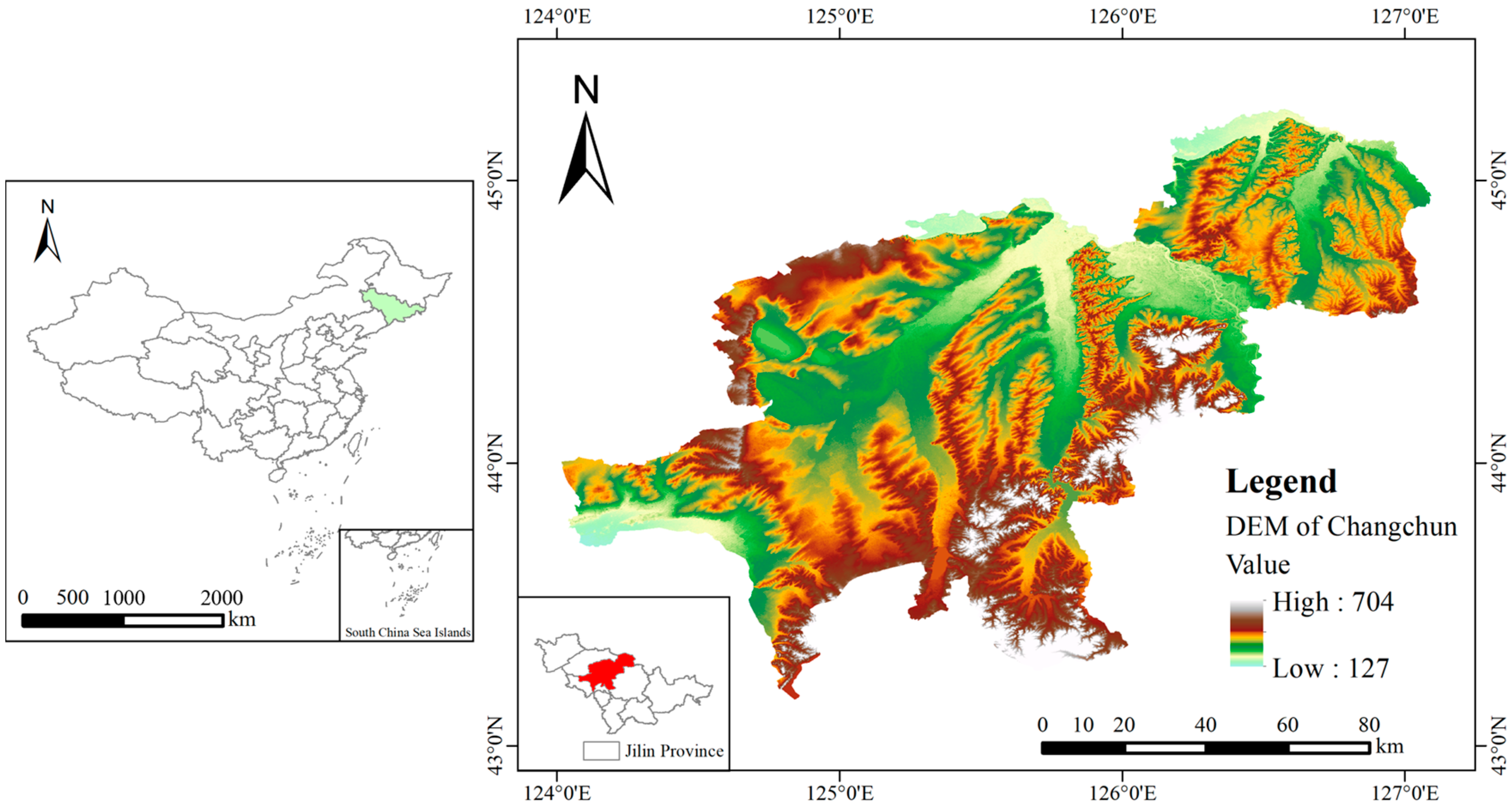
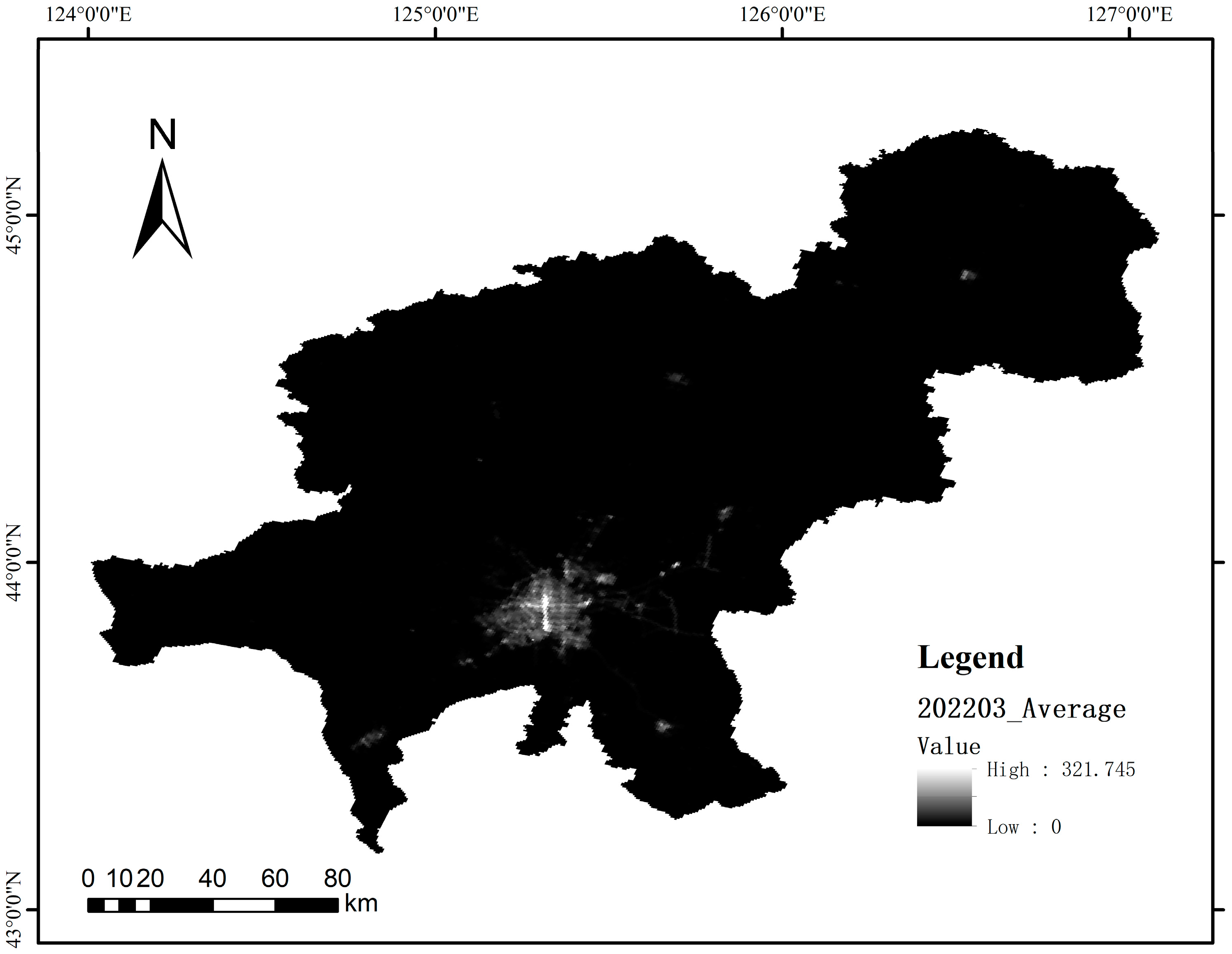


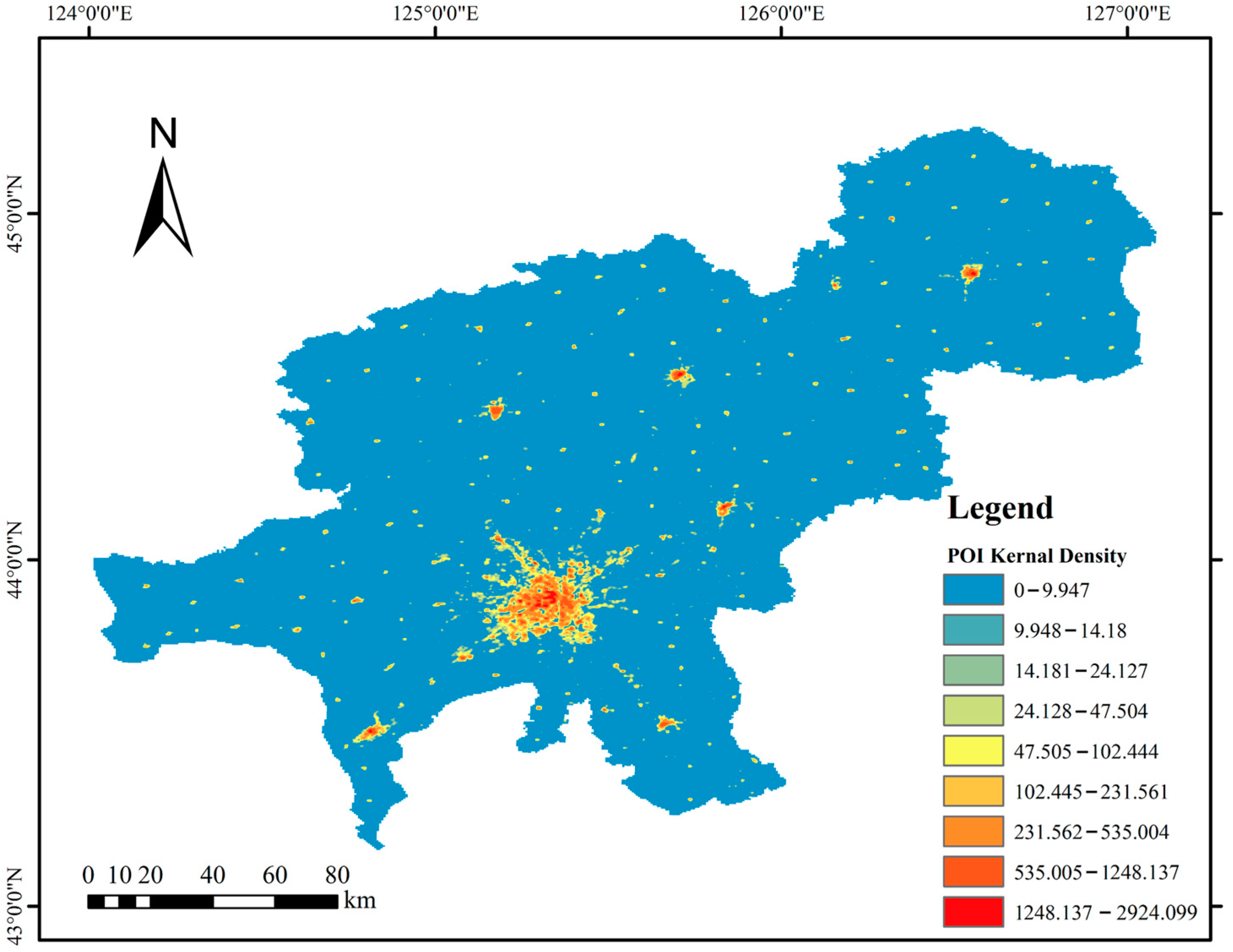
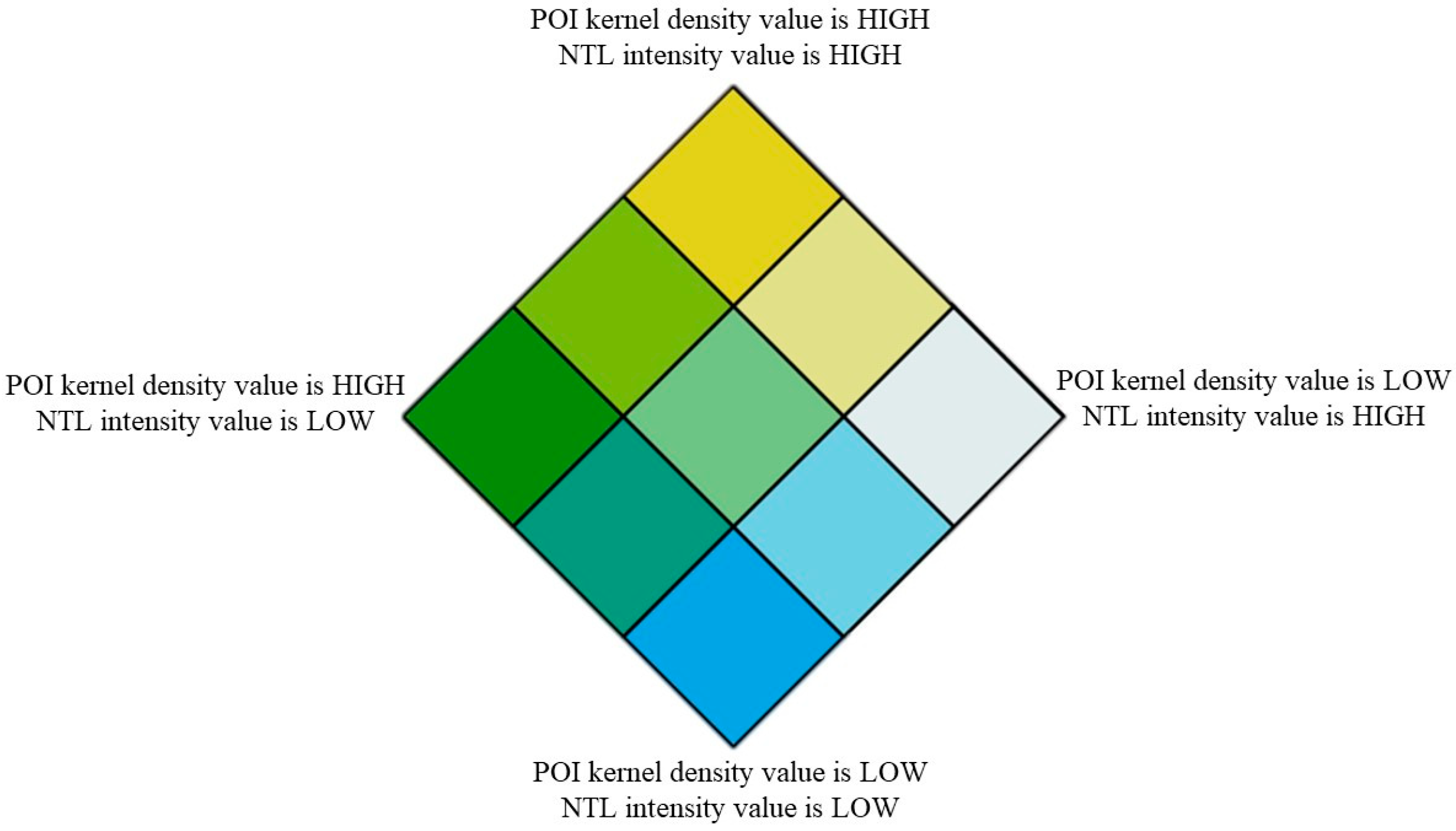
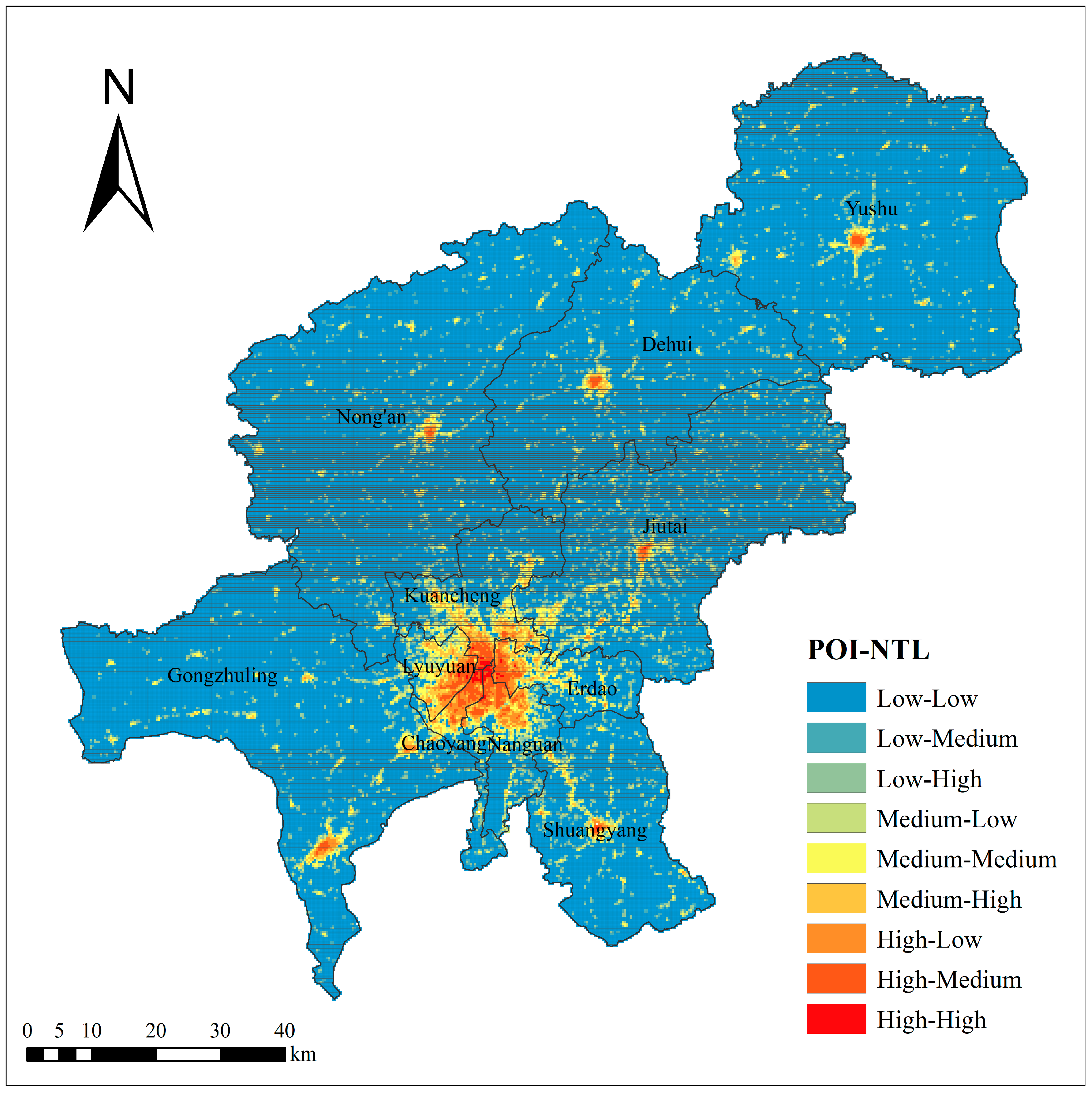

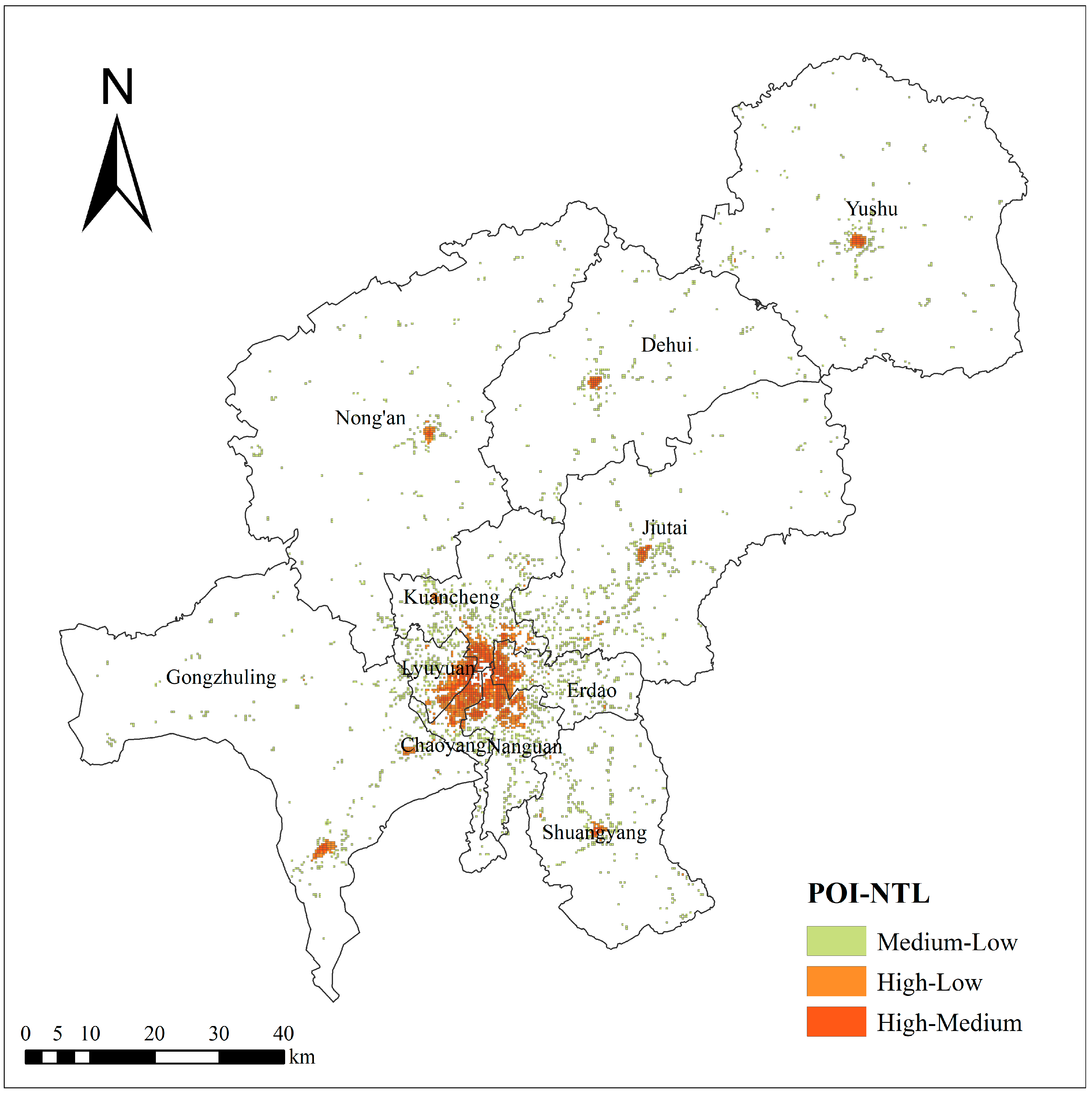
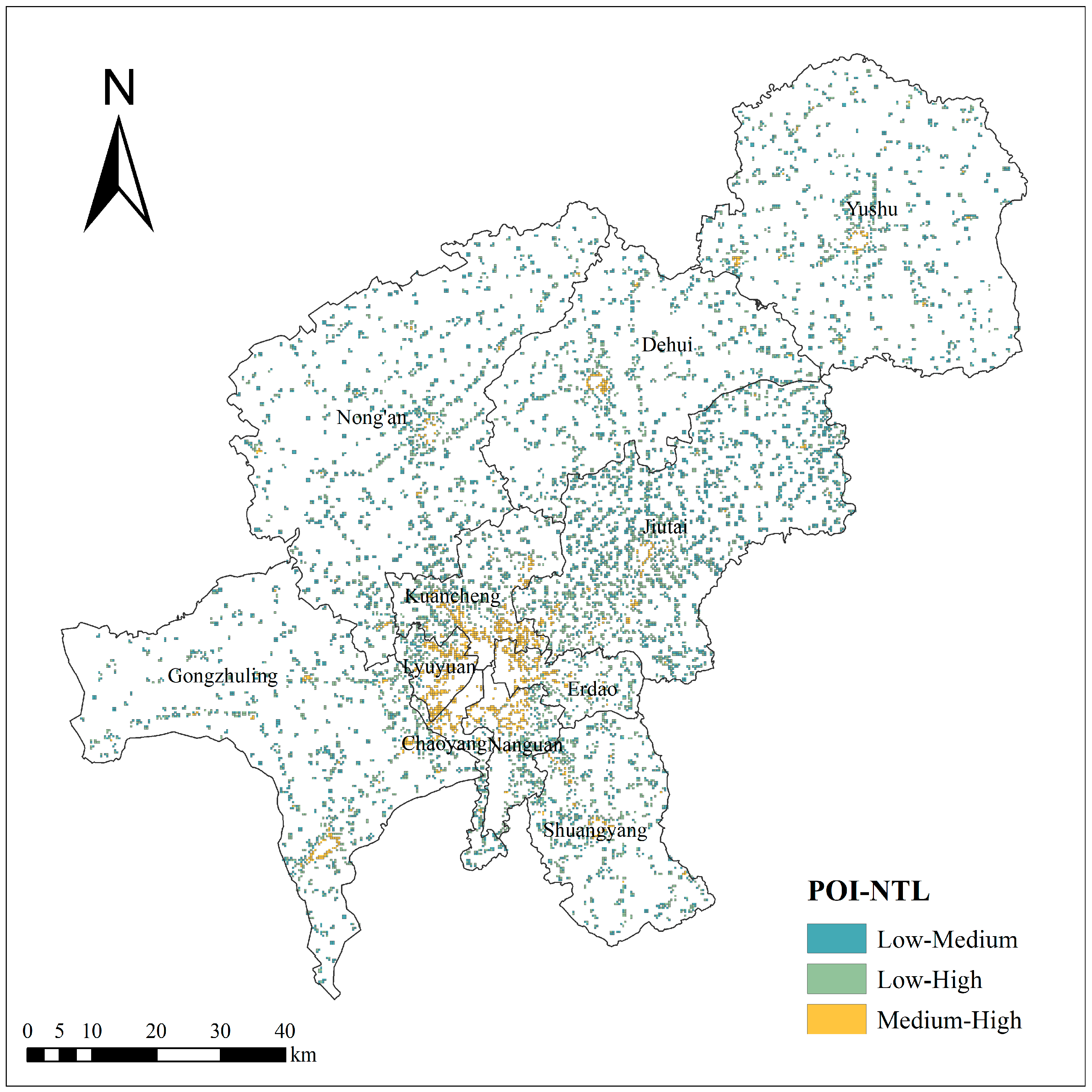
| Data Name | Resource |
|---|---|
| Basic geographic data | National Geomatics Center of China (http://www.ngcc.cn/ngcc/, accessed on 21 January 2023) |
| NPP/VIIRS NTL data | The official website of the University of Colorado (https://eogdata.mines.edu/, accessed on 18 November 2022) |
| POI | Gaode Open Platform (https://lbs.amap.com/tools/picker, accessed on 15 Febrary 2023) |
| DEM | National Catalogue Service for Geographic Information (http://www.webmap.cn, accessed on 18 November 2022) |
| Major Categories | Quantity | Percentage/% |
|---|---|---|
| Spending on Shopping | 62,200 | 26.88% |
| Dining and Gourmet | 42,050 | 18.17% |
| Life Services | 28,697 | 12.40% |
| Company Enterprise | 17,806 | 7.69% |
| Transportation Facilities | 16,802 | 7.26% |
| Healthcare | 15,468 | 6.68% |
| Automotive-Related | 14,478 | 6.26% |
| Science, Education, and Culture | 12,568 | 5.43% |
| Business Residence | 6163 | 2.66% |
| Hotel Accommodation | 5272 | 2.28% |
| Financial institutions | 4015 | 1.74% |
| Recreation | 2461 | 1.06% |
| Sports and Fitness | 2258 | 0.98% |
| Tourist Attractions | 1167 | 0.50% |
| Coupling Relationship | Number of Pixels | Percentage |
|---|---|---|
| High–High | 88 | 0.09% |
| Medium–Medium | 1823 | 1.81% |
| Low–Low | 83,195 | 82.68% |
| High–Medium | 676 | 0.67% |
| High–Low | 890 | 0.88% |
| Medium–Low | 2433 | 2.42% |
| Medium–high | 1218 | 1.21% |
| Low–High | 4821 | 4.79% |
| Low–Medium | 5476 | 5.44% |
| Total | 100,620 | 100.00% |
| Administrative Region | Gross Regional Product (Billion Yuan) | Population (10,000 People) | Fiscal Revenue (Billion Yuan) |
|---|---|---|---|
| Nanguan | 445.3 | 48.8 | 60.2 |
| Chaoyang | 727.5 | 59.2 | 64.8 |
| Kuancheng | 306.2 | 38.8 | 37.5 |
| Erdao | 213.3 | 33.0 | 32.4 |
| Lyuyuan | 285.6 | 42.7 | 49.6 |
| Shuangyang | 155.8 | 36.1 | 16.1 |
| Jiutai | 236.5 | 72.0 | 20.8 |
| Nong’an | 292.3 | 111.7 | 21.2 |
| Yushu | 269.4 | 120.5 | 12.2 |
| Dehui | 249.3 | 87.0 | 16.4 |
| Gongzhuling | 336.3 | 101.4 | 29.4 |
Disclaimer/Publisher’s Note: The statements, opinions and data contained in all publications are solely those of the individual author(s) and contributor(s) and not of MDPI and/or the editor(s). MDPI and/or the editor(s) disclaim responsibility for any injury to people or property resulting from any ideas, methods, instructions or products referred to in the content. |
© 2023 by the authors. Licensee MDPI, Basel, Switzerland. This article is an open access article distributed under the terms and conditions of the Creative Commons Attribution (CC BY) license (https://creativecommons.org/licenses/by/4.0/).
Share and Cite
Wu, Z.; Wei, X.; He, X.; Gao, W. Identifying Urban Built-Up Areas Based on Spatial Coupling between Nighttime Light Data and POI: A Case Study of Changchun. Buildings 2024, 14, 19. https://doi.org/10.3390/buildings14010019
Wu Z, Wei X, He X, Gao W. Identifying Urban Built-Up Areas Based on Spatial Coupling between Nighttime Light Data and POI: A Case Study of Changchun. Buildings. 2024; 14(1):19. https://doi.org/10.3390/buildings14010019
Chicago/Turabian StyleWu, Ziting, Xindong Wei, Xiujuan He, and Weijun Gao. 2024. "Identifying Urban Built-Up Areas Based on Spatial Coupling between Nighttime Light Data and POI: A Case Study of Changchun" Buildings 14, no. 1: 19. https://doi.org/10.3390/buildings14010019
APA StyleWu, Z., Wei, X., He, X., & Gao, W. (2024). Identifying Urban Built-Up Areas Based on Spatial Coupling between Nighttime Light Data and POI: A Case Study of Changchun. Buildings, 14(1), 19. https://doi.org/10.3390/buildings14010019






